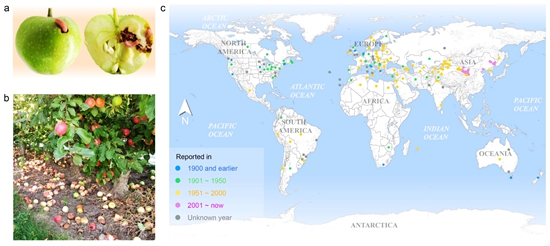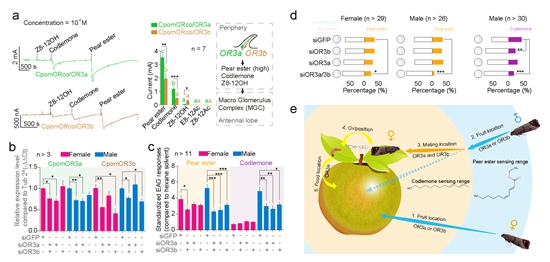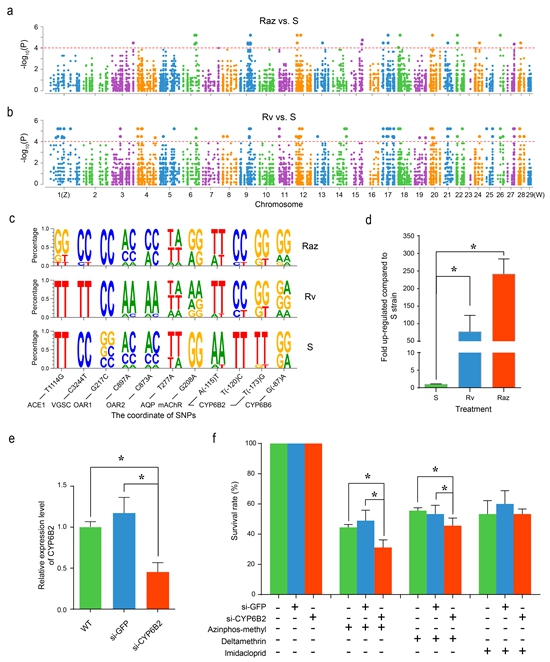The inherent genetic superiority drove codling moth's global spread and invasion
Recently, a paper entitled “A chromosome-level genome assembly of Cydia pomonella provides insights into chemical ecology and insecticide resistance” published in Nature Communications, reported a highly-contiguous genome assembly for codling moth along with results from several molecular genetic experiments that revealed novel aspects of olfaction biology and insecticide resistance in this species. This work was led by Prof. Wan Fanghao and his research group from the Department of Biological Invasion of Institute of Plant Protection (IPP),CAAS. Completion of this work resulted from collaborative efforts of more than 40 scientists from 7 countries (China, USA, France, Italy, UK, Czech Republic and Germany), who joined together to form the International Consortium on Codling Moth Genome Sequencing.
The codling moth, Cydia pomonella (Lepidoptera, Tortricidae) (Fig. 1a), is a notorious insect pest of apple, pear, and walnut trees capable of causing severe agricultural damage (Fig. 1b) and economic losses. Originating in Mediterranean Europe, codling moth has spread to 70 countries around the world over the last century (Fig. 1c) and is currently on the quarantine lists of more than 20 countries that face a high risk of invasion. In addition to concerns about invasion, the established codling moth populations were proving increasingly difficult to control due to the evolution of resistance to several forms of insecticide, both chemical and viral ones.

Figure 1 Geographic distribution and damage of the codling moth
Motivated by these daunting problems, the idea of sequencing the codling moth genome was first proposed in 2014. As the project and collaborations, a couple of primary lines of investigation emerged, focusing on 1) olfactory reception and codling moth’s ability to find food and mates and 2) genomic features underlying adaptation to acute biotic stress such as insecticides, both of which are major concerns in light of the codling moth’s ongoing global spread and invasiveness. Complementing these biological investigations was the technical challenge of embracing emerging genomic technologies such long-read sequencing, optical mapping, and Hi-C to generate a highly contiguous assembly.
The authors achieved the first genome assembly with chromosome-level scaffolds without linkage mapping for lepidopteran insects sequenced from whole organisms. This is particularly notable because codling moth has a large and repetitive genome ,compared to other Lepidoptera. Concerning olfactory reception, this assembly and its annotation revealed an unexpected duplication of an olfactory receptor gene (OR3) whose products, as they functionally confirmed, enhance the ability of codling moth to exploit kairomones and pheromones in locating both host plants and mates (Fig. 2). It is an unusual finding that a single receptor (and its duplicate) is able to detect compounds involved in mate and oviposition site detection, since most moth pheromone receptors are specifically tuned to pheromone only. They also conducted genome-wide association studies to identify hundreds of single nucleotide polymorphisms (SNPs) potentially associated with insecticide resistance, and functionally confirmed CYP6B2 (includes three SNPs in its promoter) contributes to the resistance of insecticides of codling moth (Fig. 3).

Figure 2 Functional demonstration of CpomOR3a/CpomOR3b in pear ester and codlemone olfactory reception of the codling moth, Cydia pomonella.

Figure 3 Genes involved in insecticide resistance revealed by genome data of the codling moth, Cydia pomonella.
In summary, the high-quality assembly revealed new features in olfactory and detoxification processes in Lepidoptera, suggesting the codling moth has distinct capabilities and adaptive potential, which may explain its worldwide expansion and provide new insights into insect pest globalization and destructiveness. This work will facilitate future genetic studies on the adaptation of codling moth to global agriculture changes and support the development of sustainable strategies for pest control. The international consortium This research effort and that pursued it also serves as an excellent example of a diverse and global approach to scientific research.
Codling moth is one of the first batch of species sequenced under the ‘IAS1000 Project’- A genome project of 1000 invasive alien species jointly proposed by China and international cooperation of IAS Alliance (more than 40 institutions are involved). The ‘IAS1000 Project’ aims to employ genomic methods to address the genetic basis of alien species’ invasiveness and their interactions with the ecosystem during the process of invasion, with the ultimate goal of discovering new opportunities for pest control.
Wan Fanghao from IPP-CAAS, Yin Chuanlin from Zhejiang University (ZJU), Tang Rui from MARA-CABI Joint Laboratory for Bio-safety, Chen Maohua from Northwest Agricultural & Forestry University, Wu Qiang and Huang Cong from IPP-CAAS are the co-first authors. Wan Fanghao and Yang Nianwan from IPP-CAAS, James R. Waters from University of Kansas, and Li Fei from ZJU are the co-corresponding authors. This work was supported by the National Key Research and Development Project of China (2016YFC1200602, 2017YFC1200602, and 2016YFC1201200), National Natural Science Foundation of China (31672033) and China’sdonation to the CABI Development Fund.
More details can be found below:
https://www.nature.com/articles/s41467-019-12175-9
By Yang Nianwan (yangnianwan@caas.cn)
-
 Apr 18, 2024Opening Ceremony of the Training Workshop on Wheat Head Scab Resistance Breeding and Pest Control in Africa Held in CAAS
Apr 18, 2024Opening Ceremony of the Training Workshop on Wheat Head Scab Resistance Breeding and Pest Control in Africa Held in CAAS -
 Apr 03, 2024IPPCAAS Co-organized the Training Workshop on Management and Application of Biopesticides in Nepal
Apr 03, 2024IPPCAAS Co-organized the Training Workshop on Management and Application of Biopesticides in Nepal -
 Mar 28, 2024Delegation from the School of Agriculture and Food Science of University College Dublin, Ireland Visit to IAS, CAAS
Mar 28, 2024Delegation from the School of Agriculture and Food Science of University College Dublin, Ireland Visit to IAS, CAAS -
 Mar 25, 2024Director of World Food Prize Foundation visited GSCAAS
Mar 25, 2024Director of World Food Prize Foundation visited GSCAAS -
 Mar 20, 2024Institute of Crop Sciences (ICS) and Syngenta Group Global Seeds Advance Collaborative Research in the Seed Industry
Mar 20, 2024Institute of Crop Sciences (ICS) and Syngenta Group Global Seeds Advance Collaborative Research in the Seed Industry
